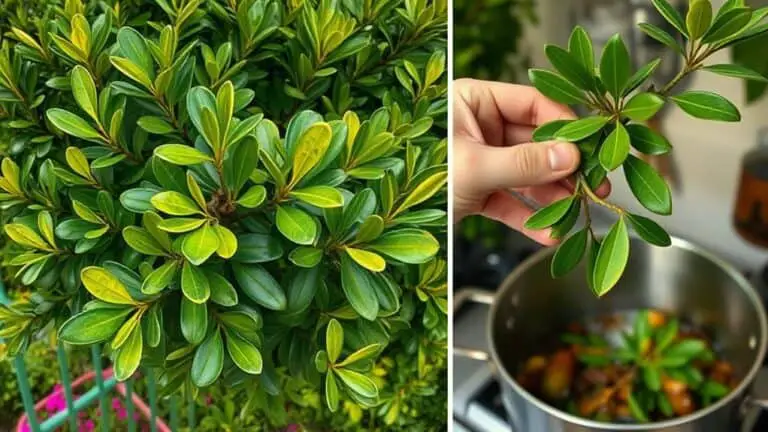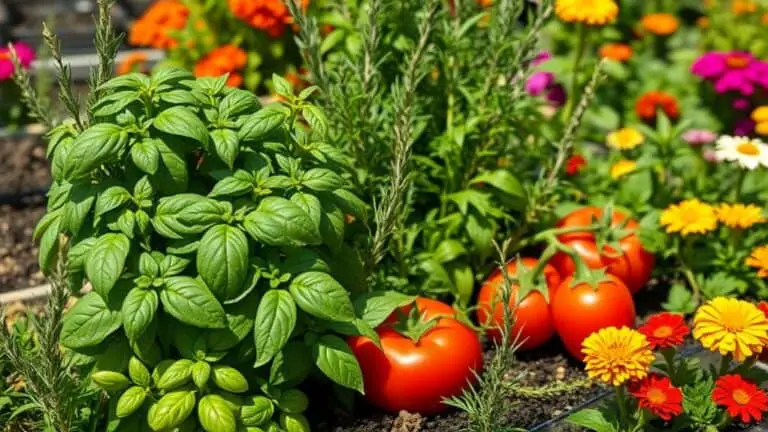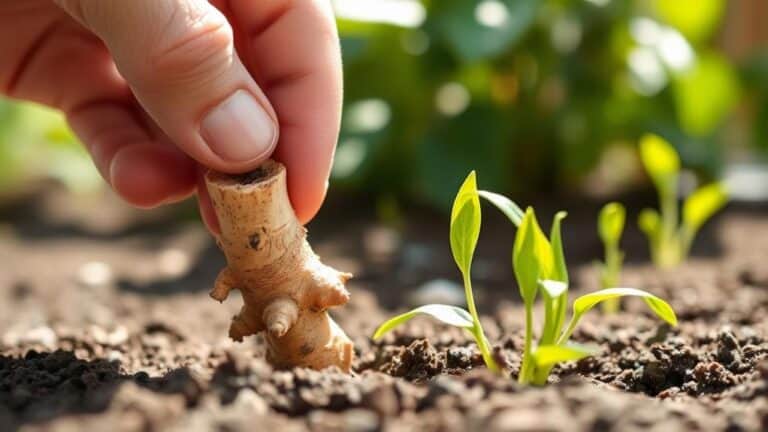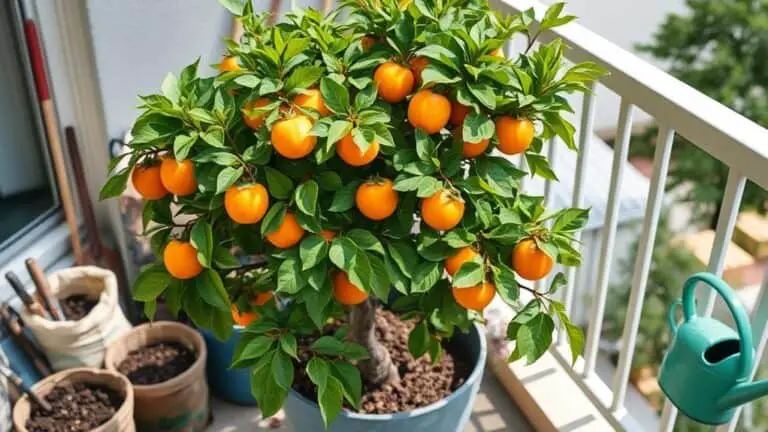How Much Space Should Leave Around Lavender When Planting
When planting lavender, it's crucial to evaluate the specific variety to determine the appropriate spacing. For instance, English lavender needs about 12 to 18 inches between plants, while French and Spanish types require more room, around 2 to 3 feet. Lavandin, with its larger growth, demands even more space, roughly 3 to 4 feet apart. But spacing isn't just about accommodating size; there are other important factors at play. If we don't get this right, we might face issues with plant health and airflow. Let's explore why proper spacing is critical for a thriving lavender garden.
Ideal Spacing Guidelines

When planting lavender, getting the spacing right is key to guaranteeing the plants thrive.
English lavender plants should be spaced 12 to 18 inches apart in your flower bed. This allows for compact growth and promotes good air circulation, which helps keep diseases at bay.
French lavender, on the other hand, needs more room, so space them 2 to 3 feet apart to accommodate their larger flower heads.
Adequate spacing also guarantees each plant has enough well-drained soil to grow a strong root system.
Always check for signs of overcrowding, like intertwined foliage, which can mean it's time to adjust your spacing.
Following these guidelines will help your lavender plants stay healthy and beautiful.
Factors Influencing Spacing
Determining the right spacing for lavender plants involves understanding several key factors.
To begin with, the mature size of the variety is essential. For example, English lavender needs 12 to 18 inches, while French lavender requires 2 to 3 feet.
Growth rate also matters; faster-growing varieties should be spaced further apart to avoid overcrowding.
Sunlight needs affect plant arrangement. In shaded areas, wider spacing guarantees each plant gets enough light.
Soil conditions play a role too. Good drainage and fertile soil help plants thrive, but poor soil might need extra spacing to boost air circulation and prevent disease.
Proper spacing promotes healthy air flow around plants, reducing fungal risks and encouraging robust blooms.
Spacing by Lavender Variety
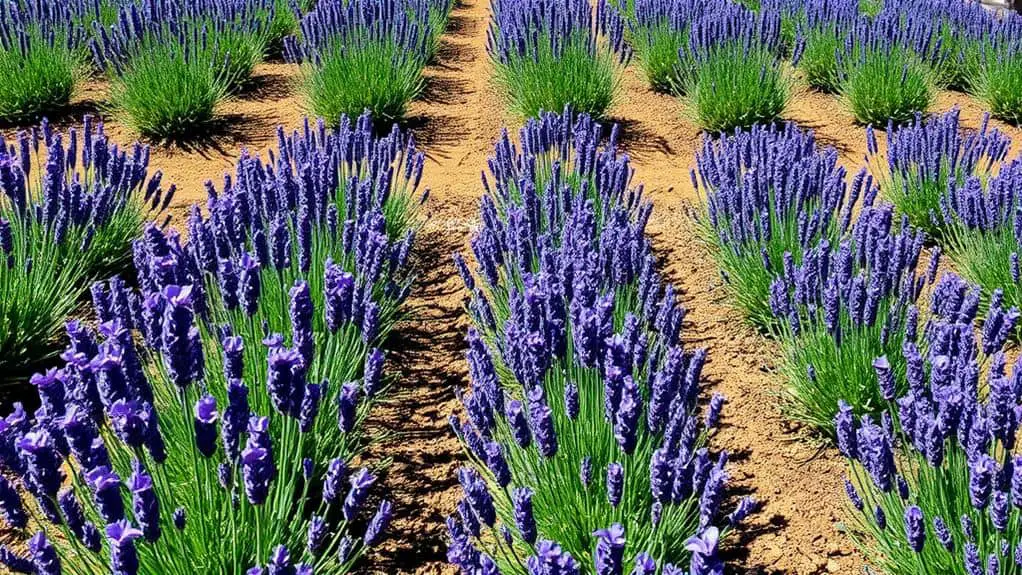
Understanding the appropriate spacing for different lavender varieties is essential for their healthy growth.
When planting English lavender, I recommend spacing them 12 to 18 inches apart. This allows for compact growth and good airflow.
French lavender, on the other hand, needs more room—about 2 to 3 feet between plants—to accommodate its larger flower heads.
For Spanish lavender, use the same spacing of 2 to 3 feet to prevent overcrowding.
Lavandin varieties grow even larger, so plant them 3 to 4 feet apart.
Proper spacing by lavender variety promotes robust root systems, enhances air circulation, and reduces the risk of disease.
Preparing the Planting Bed
Before planting your lavender, you'll need to prepare the planting bed to guarantee the best growth.
Make sure the soil has good drainage and is slightly alkaline, with a pH between 6.5 and 7.5.
Clear away any weeds or debris, and mix in some coarse compost to improve soil structure and drainage.
Soil Preparation Steps
Getting your soil ready for planting lavender is essential for ensuring healthy growth and vibrant blooms.
Start with soil preparation by conducting a soil analysis to check nutrient levels and soil pH. Lavender grows best in slightly alkaline soil, with a pH between 6.5 and 7.5.
Add 1 inch of coarse compost into the top 4-8 inches of soil to improve drainage and aeration. Organic matter like compost is vital for healthy lavender.
If your soil is heavy or clay-like, mix in builders sand to enhance drainage. Clear the planting area of weeds and debris, as lavender doesn't compete well with weeds.
For the best drainage, consider building raised beds to prevent waterlogging.
Drainage Considerations
Proper drainage is absolutely essential when preparing the planting bed for lavender, as this aromatic herb thrives in well-drained, sandy soils and quickly suffers from root rot in waterlogged conditions.
To guarantee good drainage, mix coarse compost and builders sand into the native soil. This will help create the perfect, well-drained environment for your lavender.
Dig a hole twice as deep and wide as the root ball to give roots room to expand. If your soil is heavy clay or compacted, consider using raised beds. This improves drainage and soil quality.
Don't forget to test the soil pH; lavender prefers a slightly alkaline range of 6.5 to 7.5. Proper preparation will help your lavender flourish.
Importance of Air Circulation

When it comes to planting lavender, proper air circulation is key to reducing disease risk and promoting healthy growth.
By spacing your lavender plants 12 to 24 inches apart, you allow air to move freely, which helps prevent humidity build-up and diseases like powdery mildew.
This spacing also guarantees your lavender thrives, producing the aromatic oils we all love.
Reducing Disease Risk
Ensuring adequate air circulation around your lavender plants is essential for keeping them healthy and disease-free. Proper spacing of 12 to 24 inches between plants helps prevent fungal diseases like powdery mildew. When you avoid overcrowding, you reduce humidity levels, which lowers the risk of disease. Lavender thrives in well-drained conditions, so spacing also helps prevent root rot.
Here's a handy table to remember:
| Aspect | Importance | Result |
|---|---|---|
| Spacing | 12 to 24 inches | Prevents overcrowding |
| Air Circulation | Reduces humidity | Lowers disease risk |
| Well-Drained Soil | Mitigates root rot | Healthier plants |
Promoting Healthy Growth
Recognizing the need for air circulation is essential for promoting healthy growth in your lavender plants. Proper spacing between 12-24 inches, depending on the variety, guarantees they aren't overcrowded.
This spacing allows for adequate airflow around the foliage, reducing humidity and minimizing the risk of diseases like powdery mildew. Good air circulation is key for healthy growth, as it lets sunlight reach all parts of the plant, boosting photosynthesis and overall vigor.
Overcrowding can lead to competition for resources, which inhibits growth and lowers flower production. Plus, maintaining proper spacing makes pruning and harvesting easier, further promoting plant health.
Adjusting for Growth Rate
To guarantee your lavender thrives, you'll need to adjust for its growth rate right from the start. Different lavender cultivars have varying spacing needs. For example, English lavender grows about 18-24 inches tall and needs 12-18 inches of space, while French lavender might need 2-3 feet.
It's essential to plan for adequate air circulation to prevent disease and support healthy plant development.
Here's how to adjust for growth rate:
- Observe early growth: Check for intertwined foliage, which signals overcrowding.
- Space based on mature size: Lavandin varieties should be spaced 3-4 feet apart.
- Monitor regularly: Keep an eye on plant development and adjust spacing as needed.
Managing Overcrowding
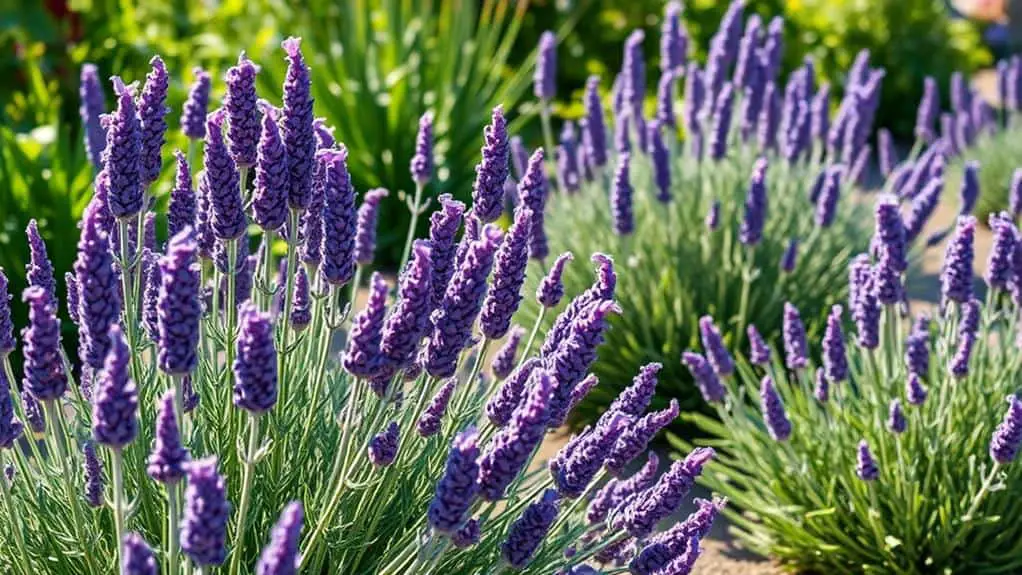
When adjusting for the growth rate of your lavender, it's easy to overlook how quickly overcrowding can become a problem.
Overcrowding happens when plants are spaced too closely, leading to intertwined foliage and poor air circulation, which can invite disease. To manage this, regularly monitor your lavender. If you see foliage intertwining or plants appearing crowded, it's a sign that your spacing needs adjustment.
Proper spacing, usually 12-24 inches depending on the variety, guarantees good air circulation and nutrient access. If you notice overcrowding, selectively remove some plants or trim back foliage. This promotes healthy blooms and robust root development.
Maintaining the right spacing helps prevent stunted growth and keeps your lavender thriving.
Planting Techniques
When planting lavender, I always focus on giving each plant enough room to grow without crowding its neighbors.
For English lavender, spacing plants 12 to 18 inches apart works well, while French lavender needs 2 to 3 feet between each plant due to its larger size.
Optimal Planting Distance
For ideal planting distance, spacing lavender correctly is essential for healthy growth and ample air circulation.
English lavender should be spaced 12 to 18 inches apart, while French lavender needs more room, about 2 to 3 feet. This guarantees each plant has enough space to grow without crowding.
Here are some tips to achieve peak growth:
- Row Spacing: When planting in rows, leave 3 to 4 feet between rows to accommodate equipment and harvesting techniques.
- Container Planting: Use one lavender plant per pot to prevent overcrowding and guarantee healthy growth.
- Variety-Specific Spacing: Adjust your spacing based on the mature size of your lavender variety, allowing for robust root systems and foliage.
These steps will help your lavender thrive!
Spacing to Prevent Overcrowding
Having established ideal planting distances, let's explore techniques to prevent overcrowding and assure each lavender plant thrives.
For English lavender, spacing them 12 to 18 inches apart guarantees compact growth and good air circulation. French lavender needs more room; spacing of 2 to 3 feet is optimal to prevent overcrowding and accommodate its larger flower heads.
Proper spacing promotes healthy root development and minimizes disease risks caused by poor air circulation. When planting in rows, keep 2 to 3 feet between rows for easy maintenance and harvesting.
Regularly monitor mature plants for signs of overcrowding, like intertwined foliage. If you see these signs, selectively remove excess plants to maintain ideal spacing and keep your lavender garden healthy.
Monitoring Plant Health
Ensuring your lavender plants thrive involves careful monitoring of their health. To help your plants flourish, keep an eye out for signs of overcrowding, such as intertwined leaves, which can hinder airflow and boost disease risk.
Regularly checking soil moisture is essential; too much or too little water indicates stress and affects plant health.
Also, pay attention to your lavender's blooms. Abundant flowering usually means good health and proper spacing, while sparse blooms might signal issues.
Here are some tips to help:
- Check for overcrowding by observing foliage.
- Monitor soil moisture to avoid dehydration or overwatering.
- Assess bloom health for signs of abundant flowering or stress.
Tips for Successful Planting
When planting lavender, start by considering the specific spacing needs of the variety you're growing. English lavender should be spaced 12 to 18 inches apart to guarantee healthy growth and good air circulation.
For French lavender, which has larger flower heads, you'll need 2 to 3 feet of space between plants.
Think about the mature size of your lavender. True lavender grows 18 to 24 inches tall and needs adequate space to avoid overcrowding. Keep 2 to 3 feet between rows for easy harvesting and airflow, reducing disease risk.
If you're planting in containers, use one plant per pot to guarantee proper root development and drainage.
These tips will help your lavender thrive and make your planting successful.
Frequently Asked Questions
How Close Should Lavender Be Planted?
When considering lavender spacing tips, I recommend spacing English lavender 12-18 inches apart, French lavender 2-3 feet, and Lavandin 3-4 feet. Companion plants and garden design should also match lavender varieties and soil requirements for ideal growth.
How Much Space Does a Lavender Plant Need?
When considering lavender spacing, I always leave 12 to 18 inches between English lavender and 2 to 3 feet for French varieties. This guarantees ideal growth, proper soil requirements, room for companion plants, and effective pruning techniques.
How to Plant a Lavender Plant in the Ground?
When planting lavender, I use proper planting techniques: well-draining soil, full sunlight exposure, and infrequent watering. I disturb roots slightly and position the root ball evenly. Marigolds make great companion plants. This guarantees healthy growth and blooming.
Do Lavender Roots Grow Deep or Wide?
Lavender roots grow more wide than deep, with a root depth of 12-18 inches and a root spread of 2-3 feet. Good soil drainage and proper spacing with companion plants are key for lavender root health.
Conclusion
Planting lavender can be a rewarding experience, especially when you get the spacing right. Remember to give each variety the room it needs to grow healthy and strong. Whether you're planting English, French, Spanish, or Lavandin lavender, proper spacing guarantees good air circulation and reduces disease risks. So, take your time, follow these guidelines, and enjoy the beautiful blooms. You've got this, and your garden will thank you for the careful planning!


